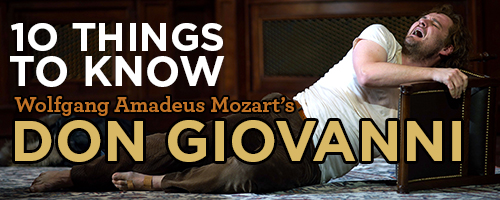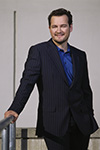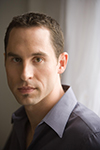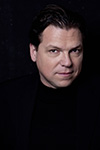-
10 Things to Know: Don Giovanni
By Kiersten HayPosted in Don GiovanniBy Nikita Gourski

As if you needed another reason: we've listed the Top 10 reasons why you can't miss Don Giovanni, a new COC collaboration with some of our prestigious peers, including Festival d’Aix-en-Provence, Bolshoi Theatre, and Teatro Real Madrid.
1. it's the Opera of operas
Musicians and music-lovers often refer to Don Giovanni as the “opera of operas.” Find out why by listening to excerpts from the stunning, genre-melding masterpiece in the Don Giovanni Listening Guide.
2. learn the basics
The legend of Don Juan originates in traditional Spanish folklore. Each treatment of the myth is different but the story typically begins with Don Juan, a shameless libertine and womanizer, forcing himself on a lady of noble birth and eventually murdering her father. The Don then pursues several other women. He is usually accompanied by a servant who is a wavering figure, sometimes reaffirming, sometimes bristling against his master’s dubious ethic. The story culminates with a dinner party, at which a stone statue (of the father killed by Don Juan) arrives at the feast and banishes the Don to Hell.
3. we're mixing it up
Collaborating with the librettist Lorenzo Da Ponte, Mozart mixed comedy and tragedy—including elements of horror—to produce a potent, even disturbing combination, which succeeded tremendously at its Prague premiere in 1787. Up until Don Giovanni, operas about the unscrupulous seducer were exclusively comedic.
4. find out who don giovanni really is
Mozart gives him only two, notably brief arias, both of which offer little information about the rake’s inner life or psychological self. Some modern critics have speculated that Mozart and Da Ponte deliberately present Don Giovanni as a blank canvas, creating a psychological space into which we, as well as the characters, project fantasies, nightmares, fears, and desires. Meanwhile 19th-century commentators like Søren Kierkegaard and E.T.A. Hoffmann became enthralled with the symbolic value of Don Giovanni, explaining him as something more than an individual man, something like a life-force, a principle of desire, or an emblem of the human soul itself, riven with the representative contradictions of the human condition. While the opera withholds any final answers, the persistence of the question explains not only the variety of directorial approaches taken over the opera’s performance history, but suggests that Mozart’s masterpiece, at least in part, depends on the ambiguous interplay of reality versus appearance, specific people versus universal representations, and physical acts versus their spiritual/aesthetic/transcendental consequence.
5. a Riveting interpretation
Our production is a collaboration between the COC and a group of prestigious peers, including Festival d’Aix-en-Provence, Bolshoi Theatre, and Teatro Real Madrid. It is staged by brilliant Russian director Dmitri Tcherniakov, “an artist whose work is on the edge of the cutting edge” (Opera News). For a full profile and analysis of Tcherniakov’s work, read Gianmarco Segato’s piece in the most recent issue of Prelude, available online here.
6. witness A faded Don
Tcherniakov’s Don Giovanni defies the stereotype of a successful Casanova; he is not particularly young or old, nor is he a carefree playboy. Rather, he’s a troubled, sometimes unhinged figure with a history—perhaps of some personal trauma, or a growing sense of disillusion—that makes him both invigorating and dangerous. Moreover he lacks any of the outward traits we’d normally associate with physical attractiveness or sexual charisma. Nonetheless, he exerts a powerful magnetism on those around him. The visual representation of the character is inspired in part by Marlon Brando’s character in Bernardo Bertolucci’s seminal film Last Tango in Paris.
7. it's All in the family
In a radical move, Tcherniakov redraws the relationships of the main characters, making them all part of a single family, which Don Giovanni—an outsider—has married into. This both complicates the relationships among the principals and generates new, revelatory meanings in their interactions. But whether we choose to take the family device literally or interpret it metaphorically, as signifying simply a closed system of human relations, the results make for powerful theatre, pushing the characters into intense emotional territory “often more meaningfully than in a straight reading” (Opera News).
8. Inside a room, worlds collide
The action is set inside a wealthy bourgeois apartment. The interior gives the impression of a respectable, well-established family. But if the Commendatore (the father, and master of this domain) represents a particular moral code, and his family members uphold a system of values consistent with that, then Don Giovanni is an eccentric force of dissent. He disrupts and rejects the family’s hierarchy of values, and, in negating a civilized morality of order and reason, transforms each of the family members for a time, estranges them from themselves, and opens a field of experience that was not accessible to them before—this can lead to moments of intoxicating madness that briefly realize Don Giovanni’s utopian vision of absolute freedom.
9. see Expanding time
Tcherniakov expands the opera’s 24 hour-time-frame into several months, inserting temporal gaps of days and weeks in between scenes that originally unfold in direct sequence. By opening up the temporal structure of the opera this way, Tcherniakov allows for the possibility of much greater personal change in the characters—we are no longer seeing someone minute-by-minute, but returning to them after a longer period of time, in which their outlooks, motivations, and desires could have changed more substantially than in a contracted time span.
10. catch an Amazing cast

Russell Braun (Don Giovanni)
“capable of the most powerful explosions as well as the gentlest covered notes” Toronto Star

Jane Archibald (Donna Anna)
“unbelievable mastery of singing… technical ease combined with a remarkable dramatic presence” Le Figaro

Kyle Ketelsen (Leporello)
“naturally beautiful, superbly trained voice, rich and clear at the low end, smooth and flexible in the middle range and effortless at the top” Opera News

Michael Schade (Don Ottavio)
“one of the most sought after lyric tenors in the world” La Scena Musicale

Jennifer Holloway (Donna Elvira)
“commands admiration for what she achieves vocally” Evening Standard
To find out more about our upcoming production of Don Giovanni, click here.
Photo Credits (top down): Russell Braun as Don Giovanni in the Canadian Opera Company/Teatro Real Madrid (TRM)/Festival d’Aix-en-Provence/Bolshoi Theatre co-production of Don Giovanni, 2013, TRM. Photo: Javier del Real. Russell Braun Headshot, Photo: Johannes Ifkovits. Jane Archibald Headshot. Kyle Ketelsen Headshot, Photo: Dario Acosta. Michael Schade Headshot, Photo: Harald Hoffmann. Jennifer Holloway Headshot, Photo: Arielle Doneson.
